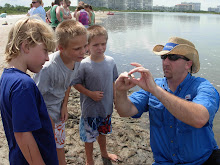In the video, Dr. Hilborn discusses the relative environmental impacts of world capture fisheries compared to other forms of animal and land-based production. He also discusses the status of global capture fisheries based on current findings from he and his colleagues (ironically this includes other researchers who he once heavily criticized for their views on the subject). I think you might be surprised on what they discovered!! The video is approximately 20 minutes long, but is very informative. Enjoy!
Friday, July 8, 2011
An Interesting Perspective on the State of World Capture Fisheries
In 2008 global fisheries production was estimated to be approximately 90 millions tonnes, which has remained relatively stable over the past decade. According to the UN Food and Agriculture Organization's State of World Fisheries and Aquaculture Report , " 15 percent of the stock groups monitored by FAO were estimated to be underexploited (3 percent) or moderately exploited (12 percent) and able to produce more than their current catches. This is the lowest percentage recorded since the mid-1970s. Slightly more than half of the stocks (53 percent) were estimated to be fully exploited and, therefore, their current catches are at or close to their maximum sustainable productions, with no room for further expansion. The remaining 32 percent were estimated to be overexploited (28 percent), depleted (3 percent) or recovering from depletion (1 percent) and, thus, yielding less than their maximum potential production owing to excess fishing pressure, with a need for rebuilding plans. This combined percentage is the highest in the time series. The increasing trend in the percentage of overexploited, depleted and recovering stocks and the decreasing trend in underexploited and moderately exploited stocks give cause for concern."
To shed some light on the complex issues of global fisheries I wanted to share with you a very insightful video from Dr. Ray Hilborn who is a professor in the School of Aquatic and Fishery Sciences from the University of Washington. Dr. Hilborn specializes in natural resource management and conservation, and is considered a leading expert in quantitative techniques for determining the abundance of fish stocks.
In the video, Dr. Hilborn discusses the relative environmental impacts of world capture fisheries compared to other forms of animal and land-based production. He also discusses the status of global capture fisheries based on current findings from he and his colleagues (ironically this includes other researchers who he once heavily criticized for their views on the subject). I think you might be surprised on what they discovered!! The video is approximately 20 minutes long, but is very informative. Enjoy!
In the video, Dr. Hilborn discusses the relative environmental impacts of world capture fisheries compared to other forms of animal and land-based production. He also discusses the status of global capture fisheries based on current findings from he and his colleagues (ironically this includes other researchers who he once heavily criticized for their views on the subject). I think you might be surprised on what they discovered!! The video is approximately 20 minutes long, but is very informative. Enjoy!
Subscribe to:
Post Comments (Atom)





No comments:
Post a Comment